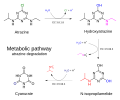ملف:Pathway Atrazine degradation.svg
محتويات الصفحة غير مدعومة بلغات أخرى.
من ويكيبيديا، الموسوعة الحرة

حجم معاينة PNG لذلك الملف ذي الامتداد SVG: 622 × 516 بكسل. الأبعاد الأخرى: 289 × 240 بكسل | 579 × 480 بكسل | 926 × 768 بكسل | 1٬234 × 1٬024 بكسل | 2٬469 × 2٬048 بكسل.
الملف الأصلي (ملف SVG، أبعاده 622 × 516 بكسل، حجم الملف: 44 كيلوبايت)
| هذا ملف من ويكيميديا كومنز. معلومات من صفحة وصفه مبينة في الأسفل. كومنز مستودع ملفات ميديا ذو رخصة حرة. |
ملخص
| الوصفPathway Atrazine degradation.svg |
English: The s-triazine herbicide atrazine is a widely used that is persistant in the soil. It is prone to ground and surface water contamination. A range of soil bacteria, including both Gram-negative and Gram-positive strains can degrade atrazine, utilizing it as a nitrogen and carbon source. In this aerobic pathway, which has been studied in most detail in the bacterium Pseudomonas sp. ADP, atrazine is catabolized in three enzymatic steps to cyanurate, which can be further metabolized by ring cleavage to carbon dioxide and ammonia. The first enzyme, encoded by either atzA or trzN (EC 3.8.1.8), converts atrazine to hydroxyatrazine. Two additional hydrolases, encoded by the atzB (EC 3.5.99.3) and atzC (EC 3.5.99.4) genes, continue the process by removing the ethylamine and isopropylamine groups. While some organisms possess all of the required enzymes, other communities degrade atrazine by a community-approach, where different organisms have some of the enzymes, and the intermediates in the pathway are passed between the organisms.
References
|
||
| التاريخ | |||
| المصدر | عمل شخصي | ||
| المؤلف | J3D3 |
ترخيص
أنا، صاحب حقوق التأليف والنشر لهذا العمل، أنشر هذا العمل تحت الرخصة التالية:
هذا الملفُّ مُرخَّصٌ برخصة المشاع الإبداعي الدَّوليَّة المُلزِمة بنسب العمل إلى مُؤَلِّفه وبترخيص المُشتقَّات بالمثل 4.0.
- يحقُّ لك:
- مشاركة العمل – نسخ العمل وتوزيعه وبثُّه
- إعادة إنتاج العمل – تعديل العمل
- حسب الشروط التالية:
- نسب العمل إلى مُؤَلِّفه – يلزم نسب العمل إلى مُؤَلِّفه بشكل مناسب وتوفير رابط للرخصة وتحديد ما إذا أجريت تغييرات. بالإمكان القيام بذلك بأية طريقة معقولة، ولكن ليس بأية طريقة تشير إلى أن المرخِّص يوافقك على الاستعمال.
- الإلزام بترخيص المُشتقات بالمثل – إذا أعدت إنتاج المواد أو غيرت فيها، فيلزم أن تنشر مساهماتك المُشتقَّة عن الأصل تحت ترخيص الأصل نفسه أو تحت ترخيص مُتوافِقٍ معه.
الشروحات
أضف شرحاً من سطر واحد لما يُمثِّله هذا الملف
العناصر المصورة في هذا الملف
يُصوِّر
قيمة ما بدون عنصر ويكي بيانات
قيمة ما بدون عنصر ويكي بيانات
٧ سبتمبر 2014
٧ سبتمبر 2014
تاريخ الملف
اضغط على زمن/تاريخ لرؤية الملف كما بدا في هذا الزمن.
| زمن/تاريخ | صورة مصغرة | الأبعاد | مستخدم | تعليق | |
|---|---|---|---|---|---|
| حالي | 04:24، 7 سبتمبر 2014 |  | 622 × 516 (44 كيلوبايت) | J3D3 | User created page with UploadWizard |
استخدام الملف
الصفحة التالية تستخدم هذا الملف:
الاستخدام العالمي للملف
الويكيات الأخرى التالية تستخدم هذا الملف:
بيانات وصفية
هذا الملف يحتوي على معلومات إضافية، غالبا ما تكون أضيفت من قبل الكاميرا الرقمية أو الماسح الضوئي المستخدم في إنشاء الملف.
إذا كان الملف قد عدل عن حالته الأصلية، فبعض التفاصيل قد لا تعبر عن الملف المعدل.
| العرض | 621.51324 |
|---|---|
| الارتفاع | 516.13379 |
